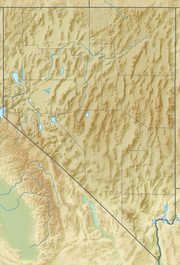Mount Moriah is a 12,072-foot (3,680 m) mountain in the northern Snake Range of eastern White Pine County, Nevada, United States. It is the fifth-highest mountain in the state,[3] and ranks as the ninth-most topographically prominent peak in the state.[5] It is located in the Mount Moriah Wilderness administered by the Humboldt-Toiyabe National Forest.
| Mount Moriah | |
|---|---|
 Mount Moriah, looking southwest from 'The Table,' in the Snake Range. | |
| Highest point | |
| Elevation | 12,072 ft (3,680 m) NAVD 88[1] |
| Prominence | 4,907 ft (1,496 m)[2] |
| Listing | |
| Coordinates | 39°16′23″N 114°11′56″W / 39.273184919°N 114.198828478°W[1] |
| Geography | |
| Location | White Pine County, Nevada, U.S. |
| Parent range | Snake Range |
| Topo map | USGS Mount Moriah |
Geography
editMount Moriah rises over 6,000 feet (1,800 m) vertical feet above the Snake Valley on its east flank, and the Spring Valley to its west.[6] The summit is the highest point in the Humboldt-Toiyabe National Forest.[2]
Immediately to the north is a large flat sub-alpine area called The Table,[7] which supports an ancient stand of Great Basin Bristlecone Pine (Pinus longaeva).[6]
The mountain is about 37 miles (60 km) east of Ely, the nearest town. U.S. Route 6 and U.S. Route 50 traverse the Sacramento Pass nearby, which divides the northern and southern sections of the Snake Range. To the south of the pass are Great Basin National Park and Wheeler Peak.
Climate
edit| Climate data for Mount Moriah 39.2745 N, 114.2001 W, Elevation: 11,522 ft (3,512 m) (1991–2020 normals) | |||||||||||||
|---|---|---|---|---|---|---|---|---|---|---|---|---|---|
| Month | Jan | Feb | Mar | Apr | May | Jun | Jul | Aug | Sep | Oct | Nov | Dec | Year |
| Mean daily maximum °F (°C) | 27.0 (−2.8) |
26.7 (−2.9) |
31.8 (−0.1) |
35.8 (2.1) |
44.8 (7.1) |
56.4 (13.6) |
65.2 (18.4) |
63.8 (17.7) |
55.6 (13.1) |
44.2 (6.8) |
33.1 (0.6) |
26.6 (−3.0) |
42.6 (5.9) |
| Daily mean °F (°C) | 18.2 (−7.7) |
17.3 (−8.2) |
21.4 (−5.9) |
25.3 (−3.7) |
34.0 (1.1) |
44.5 (6.9) |
53.1 (11.7) |
51.9 (11.1) |
44.1 (6.7) |
33.8 (1.0) |
24.2 (−4.3) |
17.9 (−7.8) |
32.1 (0.1) |
| Mean daily minimum °F (°C) | 9.3 (−12.6) |
7.9 (−13.4) |
11.1 (−11.6) |
14.7 (−9.6) |
23.1 (−4.9) |
32.6 (0.3) |
41.1 (5.1) |
40.1 (4.5) |
32.5 (0.3) |
23.5 (−4.7) |
15.2 (−9.3) |
9.2 (−12.7) |
21.7 (−5.7) |
| Average precipitation inches (mm) | 3.65 (93) |
3.35 (85) |
3.94 (100) |
4.03 (102) |
3.07 (78) |
1.32 (34) |
1.39 (35) |
1.27 (32) |
1.79 (45) |
2.13 (54) |
2.38 (60) |
3.27 (83) |
31.59 (801) |
| Source: PRISM Climate Group[8] | |||||||||||||
References
edit- ^ a b "Mt Moriah". NGS Data Sheet. National Geodetic Survey, National Oceanic and Atmospheric Administration, United States Department of Commerce. Retrieved 2011-05-19.
- ^ a b "Mount Moriah, Nevada". Peakbagger.com. Retrieved 2011-05-19.
- ^ a b "Nevada 11,000-foot Peaks". Peakbagger.com. Retrieved 2011-05-19.
- ^ "Western States Climbers Qualifying Peak List". Climber.org. Retrieved 2016-04-07.
- ^ "Nevada Peaks with 2000 feet of Prominence". Peakbagger.com. Retrieved 2014-10-23.
- ^ a b "Ely-Wilderness-Mount Moriah". United States Forest Service. Retrieved 2014-01-28.
- ^ "The Table" (map). Gmap4. Retrieved 2011-05-19.
- ^ "PRISM Climate Group, Oregon State University". PRISM Climate Group, Oregon State University. Retrieved October 2, 2023.
To find the table data on the PRISM website, start by clicking Coordinates (under Location); copy Latitude and Longitude figures from top of table; click Zoom to location; click Precipitation, Minimum temp, Mean temp, Maximum temp; click 30-year normals, 1991-2020; click 800m; click Retrieve Time Series button.
External links
edit- "Mount Moriah (NV)". SummitPost.org. Retrieved 2008-04-04.
- Media related to Snake Range at Wikimedia Commons
